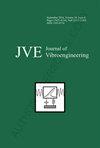Identification of the parameters of a composite material by experimental-computational damping research
IF 0.9
Q4 ENGINEERING, MECHANICAL
引用次数: 0
Abstract
Calculation of the modal and damping characteristics necessary to eliminate resonant oscillation of products made of polymeric materials requires reliable data on the elastic characteristics of the material. The problem is that the mechanical properties of polymer composite materials depend on a large number of factors. The aim of the work is to determine the damping coefficients for a layered composite material and the subsequent validation of the mathematical model. The Rayleigh damping model was chosen to calculate the damping coefficients. The choice is due to the fact that the resulting stiffness and mass matrix is determined by the natural oscillation modes of the problem without attenuation, which makes it possible to split the modes into separate dynamic subtasks. A sample made according to the ASTM standard was chosen as the object of study. To increase an error of the calculation, the mathematical model of the sample was modeled in detail by the finite element method using the technique of layer-by-layer modeling. The method for determining the damping coefficients is carried out in three stages. At the first stage, with the help of modal analysis, the natural oscillation modes are determined, corresponding to the nature of the oscillation studied in the experiment. At the second stage, an implicit dynamic analysis with default damping parameters in order to calculate the damping ratio is performed. At the last stage, a steady-state dynamic analysis taking into account the characteristics obtained in the previous stages. Next, an iterative process begins, including implicit and steady-state dynamic analyses, performed alternately. At each step, the previously calculated Rayleigh proportionality coefficients are introduced into the model. As a result of the identification of the mathematical model, the damping coefficients α and β are calculated. The damping experiment was chosen as a validation problem. The damping ratio ζ was chosen as the criterion of convergence with the experimental data.用实验-计算阻尼法研究复合材料的参数辨识
计算消除由聚合物材料制成的产品的共振振荡所需的模态和阻尼特性需要关于材料的弹性特性的可靠数据。问题是聚合物复合材料的力学性能取决于许多因素。这项工作的目的是确定层状复合材料的阻尼系数,并随后验证数学模型。采用瑞利阻尼模型计算阻尼系数。之所以选择,是因为所得到的刚度和质量矩阵是由问题的自然振荡模式决定的,而没有衰减,这使得将这些模式划分为单独的动态子任务成为可能。选择根据ASTM标准制备的样品作为研究对象。为了增加计算误差,采用逐层建模技术,采用有限元方法对样品的数学模型进行了详细的建模。确定阻尼系数的方法分三个阶段进行。在第一阶段,借助模态分析,确定了与实验中研究的振荡性质相对应的固有振荡模式。在第二阶段,使用默认阻尼参数进行隐式动力学分析,以计算阻尼比。在最后阶段,稳态动力学分析考虑了前几个阶段获得的特性。接下来,开始迭代过程,包括交替执行的隐式和稳态动态分析。在每个步骤中,将先前计算的瑞利比例系数引入到模型中。作为数学模型识别的结果,计算了阻尼系数α和β。选择阻尼实验作为验证问题。选择阻尼比ζ作为与实验数据收敛的标准。
本文章由计算机程序翻译,如有差异,请以英文原文为准。
求助全文
约1分钟内获得全文
求助全文
来源期刊

Journal of Vibroengineering
工程技术-工程:机械
CiteScore
1.70
自引率
0.00%
发文量
97
审稿时长
4.5 months
期刊介绍:
Journal of VIBROENGINEERING (JVE) ISSN 1392-8716 is a prestigious peer reviewed International Journal specializing in theoretical and practical aspects of Vibration Engineering. It is indexed in ESCI and other major databases. Published every 1.5 months (8 times yearly), the journal attracts attention from the International Engineering Community.
 求助内容:
求助内容: 应助结果提醒方式:
应助结果提醒方式:


